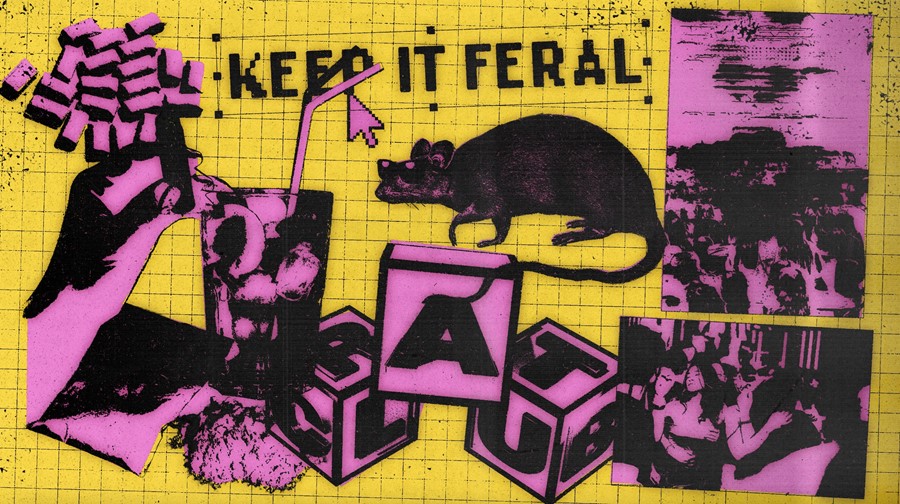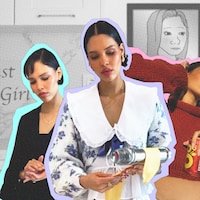Feral Girl Summer is coming...
Meet the feral club rat. She loves going out-out. Her weekends literally consist of no sleep, bus, club, another club, another club, another club, plane, next place. She lends her lip balm and gum to strangers in the bathroom. She’s chaotic, with a perpetually smashed phone screen and a diet consisting of vodka lime sodas and a pilfered ciggies. She’s like if Emily Mariko had an evil twin.
24-year-old Mollie Fraser is a self-professed feral club rat. “Being a feral club rat means you love going out and having a good time and not giving a shit what people think of you,” she says. “You’re out to let loose. You’re not standing in the corner on your phone judging people, you’re just getting out there, throwing your ass, and going feral.”
Fraser tells Dazed that began going out with her friends a lot more after COVID restrictions were lifted. “I went crazy trying to make up for lost time,” she says, explaining that she and her friends began calling themselves feral club rats as a joke. Fraser then began making TikToks referring to her lifestyle – “Me in the club after slamming five vodka sodas deciding it’s time to transform into a feral rabid rodent and scurry away from my friends to befriend strangers,” one says – and the trend has since taken on a life of its own. The hashtag #feralgirlsummer on TikTok has over 200,000 views, while videos about life as a feral club rat have amassed over 260 million.
Beyond TikTok, it’s evident that society is embracing anti-aesthetic chaos right now: just look at the ubiquity of ‘goblin mode’, dissociative feminists, the woman in her ‘Fleabag era’, or gross women like the grubby protagonist in Otessa Mosfegh’s My Year of Rest and Relaxation. But there’s a marked difference between eating instant noodles in your sweatpants and, as Fraser puts it, “getting out there and throwing your ass”. While there are similarities, feral club rats are more about embracing life rather than retreating from it.
Olivia Yallop, digital culture expert and author of Break the Internet: In Pursuit of Influence, explains further. “The feral club rat mindset is interesting to me because it’s anti-intellectual, anti-productivity culture, anti-self-optimisation. It’s about wasting time and being wasted,” she says. “There’s something a bit transgressive about being intentionally ‘messy’ on social media. You’re subverting the expectation to construct an idealised and professional image of yourself online. Feral club rats embrace and reclaim trashiness – they are anti-curated and anti-good taste.”
@__mull Starting a “that feral rat” movement instead. Club rodents ASSEMBLE #ratproverbs #clubbing #goingout #edm #fyp ♬ Dani Girl - Ranger Trucco
Many have also described the feral club rat lifestyle as the antithesis to the ‘that girl’ trend (which celebrates highly efficient women who have all their shit together). “At first, I really liked the ‘that girl’ trend. I thought it was a really great way to motivate people to embrace healthy habits,” Mollie tells me. “But as time went on, it turned into something else. It became impossible to keep up with – I would open TikTok and I kept seeing videos of these perfect girls in their perfect apartments using these super expensive products that definitely aren’t accessible to everybody. It completely disregarded the fact that life can be messy at times.” Yallop, however, is more cautious when it comes to describing the feral club rat trend as straightforwardly antithetical to the ‘that girl’ trend. “I wouldn’t overstate this cause and effect,” she says. “To me, both ‘that girl’ and the ‘feral club rat’ are just manifestations of the perennial tension between culture and counterculture playing out via the medium of TikTok vibes.”
Yallop also points out that there’s a tension between being a supposedly spontaneous, feral club rat and needing to endlessly document your exploits online. “There’s something very performative about it,” she says. “I’d argue a ‘real’ feral club rat probably wouldn’t post a long and detailed caption about all their crazy exploits. The original, late 00s feral club rats were being papped by Mark Hunter [the Cobrasnake], not taking pictures of themselves.” This chimes with the return of Indie Sleaze, a late 00s aesthetic famed for its smeared eye make-up and grimy, hedonistic abandon. It also resonates with the growing backlash against how surveillance culture is seeping into our everyday lives. There’s nothing really ‘feral’ or ‘unhinged’ about choosing the perfect filter and crafting a caption that makes you sound fun and kooky – but just the right amount of fun and kooky. “Embracing feral club rat status is a continuation of the pandemic rhetoric of everything being ‘unhinged’ or ‘chaotic’ – aestheticising something that is out of our control and converting it into a lifestyle or personal brand,” Yallop continues.
“It’s a continuation of the pandemic rhetoric of everything being ‘unhinged’ or ‘chaotic’ – aestheticising something that is out of our control and converting it into a personal brand” – Olivia Yallop
However, it’s fair to say the feral club rat ‘trend’ supersedes TikTok. According to sociologist Dr Arielle Kuperberg, the pandemic has shaped the rise of a more genuine, widespread inclination towards reckless abandon. “The roaring 20s were in part a reaction to the [so-called] Spanish flu pandemic and WWI in the decade before. So just like the 1920s, here we have a similar situation where people have been socially isolated from each other for years, and are now eager to gather together in groups,” she explains. “In sociology, we discuss the concept of ‘collective effervescence’, which is the feeling you get when a lot of people get together in the same place and engage in the same joyful action. So here we have young people who have been deprived of collective effervescence, who are finally able to experience that.”
This pattern of society experiencing a period of hardship and stoic self-restraint predates even the 1920s. Back in the 17th century, Brits were subjected to ascetic tyrant Oliver Cromwell shutting pubs and theatres and, famously, outlawing Christmas celebrations. What followed once the monarchy was restored (boo) was a dramatic and immediate reversal of puritanism (yay). According to historian Roger Baker, it was “as though the pendulum [of England's morality] swung from repression to licence more or less overnight.” A similar thing happened after the Black Death, too: contemporary chronicler Agnolo di Tura wrote that “when the pestilence abated, all who survived gave themselves over to pleasures.”
Dr Kuperberg adds that social isolation can also make people turn a little unhinged. “Hooking up, dating, clubbing, is all an arena that has social norms and rules, and a lot of people feel they have to follow certain ‘rules’ to succeed,” she explains. “Now people are two years out of practice when it comes to these social interactions, so they don’t know what the social norms are anymore. I think that plays a part too in terms of people feeling like they are ‘feral’.” Ultimately, as countless lockdowns have shown us, the freedom to have fun is not something we can take for granted. Who cares about social norms anymore? Why not run around the club like a rabid little rodent? After all, as Fraser says: “there’s nothing wrong with being a little feral.”




